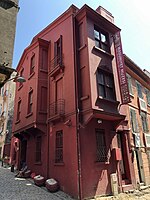İstiklal Avenue (Turkish: İstiklal Caddesi; English: Independence Avenue) historically known as the Grand Avenue of Pera (Ottoman Turkish: جادهٔ كبیر, romanized: Cadde-i Kebir; Greek: Μεγάλη Οδός του Πέραν, romanized: Megali Odos tou Peran; French: Grande Rue de Péra), in the historic Beyoğlu (Pera) district, is an 1.4 kilometre (0.87 mi) pedestrian street and one of the most famous avenues in Istanbul, Turkey. It acquired its modern name after the declaration of the Republic on 29 October 1923, İstiklal (Independence) commemorating Turkey's triumph in its War of Independence.
The street starts at the northern end of Galata (the medieval Genoese quarter) at Tünel Square and runs as far as Taksim Square. It is flanked by late Ottoman era buildings (mostly from the 19th and early 20th centuries) in a variety of styles including Neo-Classical, Neo-Gothic, Renaissance Revival, Beaux-Arts, Art Nouveau and First Turkish National Architecture. There are also a few Art Deco style buildings from the early years of the Turkish Republic, and a number of more recent examples of modern architecture. Many would once have been apartment blocks but most are now occupied by boutiques, music stores, art galleries, cinemas, theatres, libraries, cafés, pubs, nightclubs with live music, hotels, historical patisseries, chocolateries, restaurants and a steadily growing number of international chain stores. There is even a branch of Madame Tussauds.
Galatasaray Square marks the middle of the avenue and is home to the oldest secondary school in Turkey: the Galatasaray High School (Galatasaray Lisesi), originally known as the Galata Sarayı Enderun-u Hümayunu (Galata Palace Imperial School). A monument, these days fenced off as a police post, commemorates the fiftieth anniversary of the founding of the Turkish Republic in 1973.The avenue forms a spine with narrow side streets running off it like a ribcage. Many historical and politically significant buildings can be found on or immediately adjacent to Istiklal Avenue. They include the Çiçek Pasajı (Flower Passage) which is full of lively restaurants and taverns; the Balık Pazarı (The Fish Market) with the Armenian church of Üç Horan to one side; the Hüseyin Ağa Mosque; the Roman Catholic churches of Santa Maria Draperis and S. Antonio di Padova; the Greek Orthodox church of Hagia Triada; several academic institutions established by Austria, France, Germany and Italy in the 19th century; and the consulates (embassies until 1923 when these moved to the new capital of Ankara) of France, Greece, the Netherlands, Russia, Spain and Sweden (the consulate of the United Kingdom is just off Istiklal Avenue on Meşrutiyet Street).
At the southern end of the avenue, it is possible to board the Tünel (the Tunnel), the world's second-oldest subway, which entered service in 1875 and carries passengers down to Karaköy. A photogenic red-and-cream tram runs along the street from Tünel to Taksim Square every 15 minutes.










